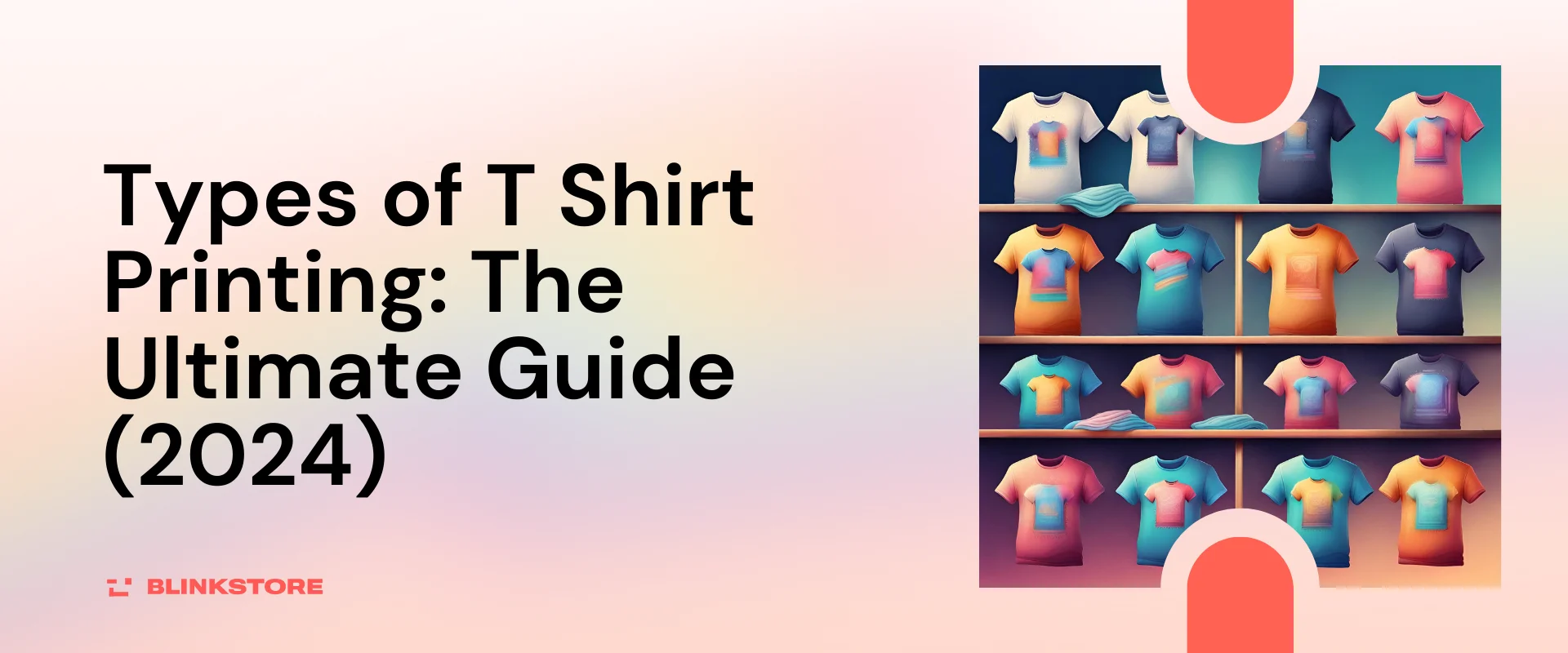This ultimate guide will reveal the pros and cons of any available t-shirt printing techniques, recommended equipment for each type of printing, key definitions traded in this industry, things to consider before designing a shirt on your own, and much more. So let’s discuss some of the basics of different types of t shirt printing and methods available.
Table of Contents
Introduction
Understanding the different types of t shirt printing is very important in determining the appropriate quality custom apparel. As illustrated from the classic screen printing to the advanced digital methods, there is a wide variety of techniques that assist in materializing designs on the t-shirts. These methods allow people and also companies to make deliberate decisions tailored according to their needs and aesthetic goals.
Understanding Types of T Shirt Printing Methods
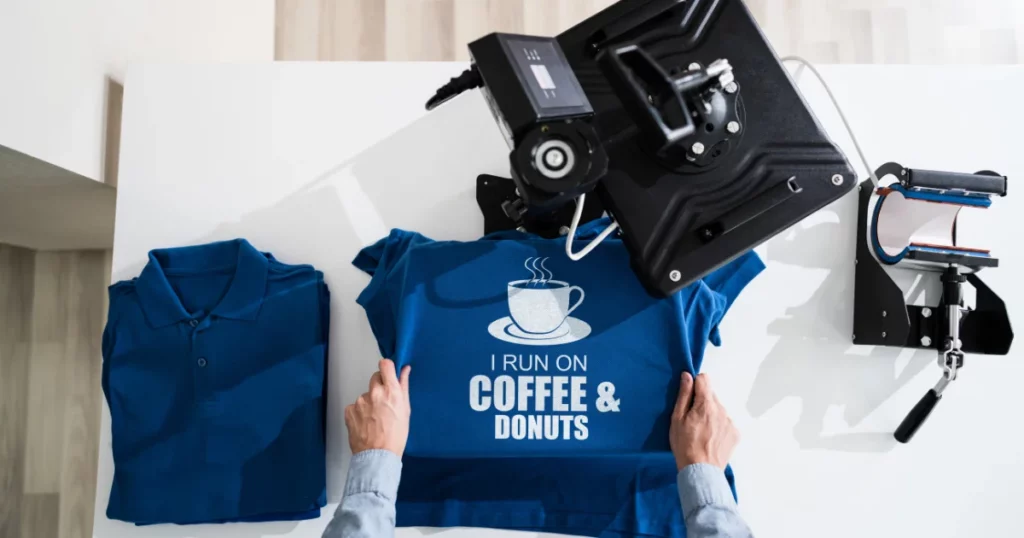
T-shirt printing means stinging graphics, designs, or text in the t shirt fabrics with ink and application gear. Various printing techniques are available, each with its specific processes. configurations, benefits, and also limitations.
T-shirt printing choice needs to take into consideration such factors as the number of colors, order quantities, printing costs structure regional location where imprints are placed among others
Let’s overview the most common techniques:
1. Screen Printing
Screen printing is one of the most popular types of t shirt printing method for many apparel businesses due to its cost efficiency, vivid results, and also distinct colors with pinpoint precision.
- How it Works: A stencil design is made and then it is applied on a fine mesh screen. A print is achieved by squeezing the ink through the openings of the screen onto a shirt. Each color has a separate stencil for it.
- Key Benefits: Vivid colors, sharp feel, cost-effective when bought in bulk, and also suitable for plain or intricate designs
- Best For Large volume orders, multi-color prints, and large imprint areas such as full chest designs
- Equipment Needed: Screens, squeegees; and exposure unit a washout booth, and a dryer
Pros:
- Cost-effective for bulk orders 100+
- Bold, vibrant imprints
- Can print multiple colors
- Durable prints
- Large imprint areas like full chest
Cons:
- Multiple setup steps
- Not ideal for lower quantities
- Can’t print fine details or gradients
2. Heat Transfer Printing
Heat print is the transfer of pre-printed vinyl graphics or transfers via a heat press onto the clothing creating an even finish. Digital transfers allow the printing of high-resolution photographic images that cannot be achieved through a screen.
- How it Works: Graphics are printed onto the transfer paper or vinyl and then heat is applied for the graphics/prints to adhere to garments.
- Key Benefits: Affordable for lower quantities, there are limitless types of color or effects and photo-realistic prints
- Best For This includes full-color photographic prints, lower-order volumes, and design with simple designs.
- Equipment: Color printer, heat press machine
Pros:
- Affordable for lower quantities
- Unlimited color capabilities
- Well-suited for simple designs
- No heavy equipment needed
Cons:
- Less soft hand feel
- Lower durability than other methods
- Limited imprint sizes
3. Direct-to-Garment Printing
DTG uses specialized printers to print the full-color designs onto the fabric. While suited to smaller numbers, DTG is often slower than the other methodologies for higher quantities but still affords photographic prints not accessible with screening.
- How it Works: Specialized DTG printers are being fed with the artwork files and directly printed upon the garments. Some apply water-based inks, while others apply solvent ones.
- Key Benefits: Full prints, with no setup costs, are the best for smaller quantities.
- Ideal for photographic designs, smaller orders with light imprint areas such as on the chest or sleeves.
- Equipment: DTG printers, heat presses, and also pretreatment machines
Pros:
- Great for photorealistic prints
- No films or setup costs
- On-demand capability
- Soft final print quality
Cons:
- Slower than other methods
- Most costly per print
- Limited imprint areas
4. Dye Sublimation
It directly dyes the fabric for t-shirts into which it infuses, and as a result of such work; you get soft yet vibrant fade-resistant prints. The process is very different from the other methods.
- How it Works: Dyes change to the gas at high temperature/pressure and then bond with the polyester fabric. Dye in excess was eliminated only to leave a print that was embedded.
- Key Benefits: Lively, built-in prints with a permanent soft touch. Ideal for gradients or wraps.
- Suitable for the best polyester performance apparel, athletic jerseys, and all-over prints
- Equipment: Dye-sub printer, heat press
Pros:
- Vibrant, embedded prints
- Works well for polyester fabrics
- Excellent for all-over prints
- Soft permanent feel
Cons:
- Only works on polyester
- Requires specialty transfer paper
- Higher equipment cost
5. Airbrushing
Airbrushing refers to using air-powered spray painting equipment to imprint designs directly onto t-shirts. It’s an artistic, freehand technique that typically uses acrylic paints applied with precision through an airbrush nozzle to create one-of-a-kind tees.
Airbrushing allows limitless creative freedom compared to template-based methods like screen printing or heat transfers. Artists control blends, textures, gradients and more. However it differs by relying on manual painter skills over printing presses or printer automation.
Pros:
- Enables fully custom paintings for one-off graphic tees
- Offers total creative flexibility unconstrained by print templates
- Achieves super-fine spray control and detail challenging by other print methods
- Creates gradients, fades and photorealism through blending
- Adds visual depth and dimension with texture layers
Cons:
- Requires high degree of artist skill to master spray control
- Not conducive to mass production or bulk orders
- More costly and slower per shirt than automated techniques
- Not foolproof as mistakes can’t be undone easily
- More setup work prepping and masking shirt areas off
Read more about: 15 Amazing Trending T-shirt Designs to Watch Out in 2024
Understanding Key Terminology
As with any industry, the world of t-shirt printing has its unique jargon. Let’s quickly define some common terms:
- Screens: Screens are perforated stencils used in screen printing for the passage of ink to transfer designs.
- Platens: a heat press component for garments’ impression on the
- Transfers: Also specially printed on the paper for ironing onto the cloth.
- Plastisol ink: The typical ink employed in t-shirt screen printing
- Curing: Heating inks for the fusion into fabric using a conveyor dryer.
- Off-Contact Printing: Removing the screen from the fabric during the printing to create a sharper ink deposit.
- Flash Sequential: Printing additional colors in sequence with flash drying between the printings.
Choosing Printing Methods
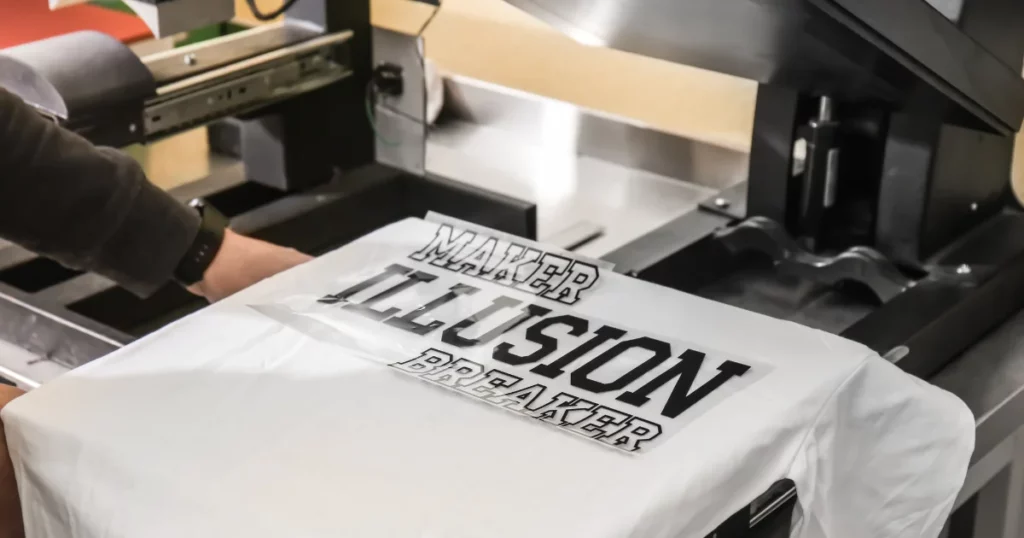
With an overview of techniques, let’s explore key factors influencing types of t shirt printing decisions:
- The ideal printing option is also influenced by the order volume as a factor that determines the size of an order. Significantly, when dealing with large volumes of 100 and above production screen printing is advised while for digital transfers the other option
- The print location limits the available options. All-over prints are sometimes dye-sublimated. Chest designs need to be full for the screening or DTG. Screen printing is also the cheapest for back prints.
- Colors The majority of colors and blends, such as gradients look the best on digital DTG or dye sub while screening traditionally excels in handling around 4 colors very cheaply.
- The printing method impacts design options. DTG or dye sub is needed for the photographic imagery as screening cannot meet the requirements. Yet, screening enables colored, bright elements to be cost-effective.
- Print Feel & Durability Screening and Dye sub leads in the softest, embedded durable prints. Transfers and DTG feel a lot lighter on the surface. When appropriately cured, all the methods are very resilient.
Read more about: Best Online T-shirt Printing Services of 2024
Maximizing Print Quality
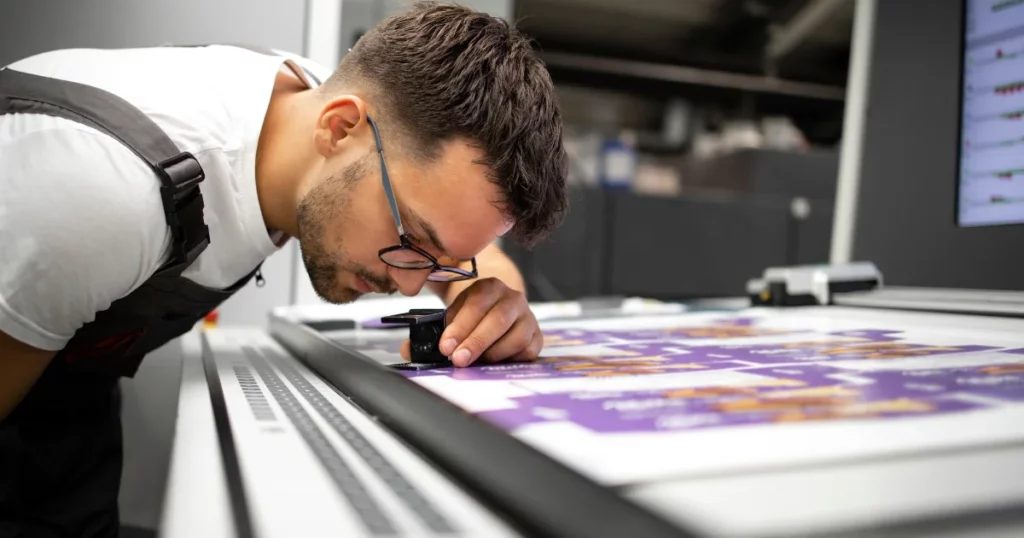
To achieve vibrant, crisp custom shirt prints, utilize these quality best practices:
1. Select High-Quality Shirts to purchase durable, high-quality soft blank shirts of at least mid-weight 4.5oz cotton. Heavier shirts hold prints better.
2. Print On the Body Side Front and center chest panels can hold prints on over seams with a low risk of distortion.
3. Thoroughly Cure Inks Using a conveyor dryer or heat press, to attain long-term wash durability fully cure and bond the ink to the fabrics.
4. For pre-treating garments, the use of white or light shirts helps enhance the ink adhesion for brighter and more durable prints while providing
5. Instead of batch printing, the print-on methods providers use Print On Demand Fulfill to provide the customers with the latest designs as well as minimize the obsolete inventory.
6. Helping your Printer Partner in choosing a seasoned printer with calibrated equipment helps improve the final imprints’ quality and consistency.
7. Look for the Location Over Speed domestic printers versus overseas whenever possible to minimize inventory risk and allow tight print control.
Read more about: How to Sell Clothes Online in India (2024 Best Guide)
Types of t shirt printings
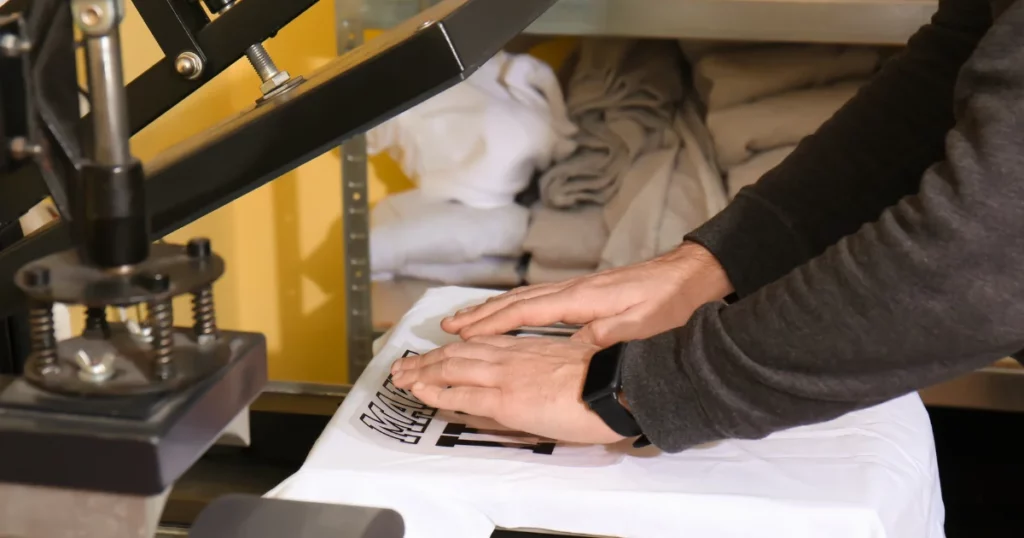
1. Screen Printing
It involves stencils and the Ink that are used in imprinting designs onto t-shirts. The large sizes make it very easy to produce simple or elaborate designs in a high quantity.
The most ubiquitous types of t shirt printing method for good reason with its unbeatable wholesale economics, screen printing remains the go-to for apparel brands seeking bold imprints on bulk tees. Here’s a quick overview:
- Works by using squeegees to force ink through stenciled screens onto shirts
- Requires an exposure unit to burn screen designs and a washout sink
- Capable of printing exact color alignments even on complex multi-layered prints
- Ideal for simple spot colors or multi-color graphics like logos and text
- Durable vibrant prints when cured properly through conveyor dryer
- Cost-effective only at higher quantities (100+)
2. Heat Transfer
Pre-printed transfer paper is pressed on using a heat press machine. Cost-effective for lower quantities.
The digital disruptor, heat transfer printing provides newcomers affordable access for smaller shirt runs versus high equipment investments for screening.
- Printed transfers applied via heat press rather than direct inks
- Enables printing small batches even single shirts cost-effectively
- Perfect for photorealistic designs with unlimited colors
- User-friendly process for beginners with lower startup costs
- Limited imprint sizes and hand feel not as soft as other methods
3. Direct-To-Garment (DTG)
Printing graphics directly onto the tees is done by direct-to-garment (DTG) Specialized printers. Enables photorealistic prints.
Direct-to-garment printing is one of the types of t shirt printing that eliminates intermediary transfers to achieve incredibly soft prints rivaling screen printing with unmatched photographic abilities.
- Specialized printers apply inks directly onto the fabric
- No minimum orders required allowing print per order quantities
- Vibrant colors and photorealistic prints possible
- Soft final print quality even on colored fabric
- Slow production speeds make higher volumes cost prohibitive
4. Dye Sublimation
Dyes are absorbed into the polyester fabric and create a soft, vibrant embedded print using a heat press.
Dye sublimation represents the top of fabric customization thanks to its ability to infuse inks directly into the shirt fabric itself for embedded prints with permanent soft feel.
- Works by turning ink into gas which bonds with polyester fabrics
- Requires a sublimation printer and heat press with specialty paper
- Enables vibrant, photorealistic, all-over prints
- Very soft permanent hand feel and stretch resistance
- Only works on polyester fabrics limiting applications
5. Foil Printing
Metallic foils Applied via heat press for chrome logos or designs that are irresistible to the eyes.
Foil printing provides showstopping metallic effects to amp up shirt designs with a glossy, reflective polish.
- Transfers metallic foil material onto fabric using adhesive glue
- Eye-catching chrome effects take designs to the next level
- Works well embellishing text and logos with foil accents
- Adds smooth, mirror-like textural element to prints
6. Discharge Printing
Bleaches out the dye to reveal the base color. Provides a stressed vintage appearance on the dark shirts.
Discharge printing produces a unique distressed vintage aesthetic perfect for band merch and urban streetwear.
- Removes dye from fabric revealing the underbase shirt color
- Works very well on darker colored fabric bases
- Grungy faded imprints differentiate from bold prints
- Can be combined with colored inks for underbase pop
7. Overprinting
Overprinting is the process of printing one color on another to obtain blended colors.
Overprinting allows blending colors to create gradients or custom secondary hues.
- Prints one color layered on top of another color ink
- Opens door for thousands more color combinations
- Make gradients between primaries like purple made with blue over red
8. Water-based ink Printing
Water-based ink Printing is environmentally friendly, they use water-soluble ink. Softer hand than plastisol.
Water-based inks provide a eco-friendly alternative to standard plastisol inks.
- More environmentally-friendly washable inks
- Cost-effective option for basic spot color prints
- Softer final hand than plastisol prints
- Faster drying requiring less heat for curing
9. Plastisol Ink Printing
The most common ink for printing is Plastisol Ink Printing. Vivid color, and smooth texture after curing.
The ink standard for professional screen printers, plastisol provides unparalled print vibrance.
- Most versatile and widely-used ink for screen printing
- Vibrant opaque colors perfect for cotton fabrics
- Smooth soft final print quality after properly cured
- The common “go-to” for screen printing high-quality tees
10. Embroidery Stitching
Involves elaborating designs and logos with a three-dimensional texture.
Embroidery stitching adds stunning dimension and texture impossible to match via graphic printing.
- Computerized embroidery machines sew thread designs
- 3D puffy logo effects promotional hats and polos incredibly
- Ideal for team uniforms, branded apparel lines
- Enables alternate revenue from stitched apparel
11. All-over printing
All-over printing is the process of Sinking a shirt into dye to achieve an allover color or pattern.
All-over printing allows submerging shirts entirely for bold allover patterns.
- Uses photosensitive dyes to color blank shirts
- Creates tie-dye patterns, camo prints, spraypaint effects
- No seams or unsightly edges like cut fabric panels
- Whole garment essentially becomes the print design
12. Ombre printing
Spray guns are used to fade from one color.
Ombre printing produces vibrant, faded color gradients.
- Blends colors from light to dark or vice versa
- No harsh edges between hues
- Utilizes spray guns to seamlessly fade colors
- Flowing, tie-dye style effect
13. 3D printing
3D printing is an Innovative technology for creating contoured prints with a highly textured surface.
3D printing enables unique contoured prints for maximum impact.
- Futuristic printing method using specialized printers
- Maps and applies designs with three-dimensional texture
- Eye-popping designs with depth unattainable flat
- Extremely innovative emerging printing technique
14. Foam Ink Printing
Thick foam ink produces a big, puffy embossing.
Foam ink generates bold, puffy prints for added dimension.
- Thick foam ink expands when heated
- Creates 3D raised logos and designs
- Distinctive cushiony finish stands out
- Multiple foam colors can be combined
15. Flocking Printing
Some velvet-like flock particles are attached with adhesion glue.
Flocking uses fine fibers to produce velvet-like prints.
- Transfers flocked particles to fabric adhesive
- Alternate to puff prints for texture interest
- Eye-catching sheen catches light uniquely
- Velvety soft finish stands out from typical prints
16. Glitter Printing
The use of glitter particles in which glitter particles are incorporated into plastisol inks.
Glitter printing incorporates shimmering particles for showstopping dazzle.
- Mixes glitter flakes into plastisol inks
- Catches and reflects light for brilliance
- Adds celebratory bling for parties or events
- Metallic gold and silver glitter popular
17. Reflective Ink Printing
Glowing prints with reflective inks and also a black light.
Reflective ink makes designs literally glow under blacklight.
- Inks contain glowing particulate compounds
- Prints seem to disappear under normal light
- Activating blacklight makes prints shine
- Mesmerizing effects for youth or nightlife shirts
18. Puff Printing
Puff Printing adds extra layers of puff ink to build up 3D logo effects.
Puff printing piles on ink layers for maximum 3D logo punch.
- Builds up extra thick ink deposits
- Creates raised rubbery logo designs
- Versatile for branding athletic gear like jerseys
- Made for shirts where logos are the hero
19. Cracking Ink Printing
For a vintage crack distressed look, Cracking Ink Printing cracks deliberately.
Cracking ink purposefully fractures creating natural vintage distressing.
- Inks contain additives to intentionally crack
- Organic weathering without artificial aging
- Built-in antiquing perfect for music shirts
- Complementary for grunge or western looks
20. Expanding Ink Printing
3D printing with Ink Printing inks that expand when heated produces raised print components as 3D prints.
Expanding ink bubbles when heated for 3D logo texture.
- Inks expand mid-curing in conveyor dryers
- Less expensive than additive puff processes
- Underutilized for dimensional logo impacts
- Reliable quality without external puff additives
21. Metallic Ink Printing
Metallic Ink Printing involves the use of reflective silver and gold inks. Eye-catching, especially on darks.
Metallic ink delivers radiant gleam with precious metal pearlescent pigments.
- Contains aluminum, gold, silver coated flakes
- Mirror-like reflective surface
- Catches light dramatically, especially on darks
- Much more affordable than foil printing
22. High-density ink Printing
High-density ink Printing is a method of very thick printing inks designed for saturating prints into dark clothing.
High-density ink powers through even the thickest fabric knits with ease.
- Extremely opaque for cotton, poly blends
- Ideal for saturating inside out black tag labels
- Provides insurance for problem fabrics
- Locks in vibrancy on the toughest materials
23. Mirrored Ink Printing
Mirrored Ink Printing is used for Reflective chrome effect inks.
Mirrored metallic ink dials designs to full glossy glam.
- Hybrid between straight metallic and foil
- Next-level reflective sheen
- Ultra-luxurious chrome effects
- Gorgeous on sophisticated apparel lines
24. Neon Ink Printing
Neon Ink Printing High-visibility prints using fluorescent, day-glow, and neon ink.
Neon ink glows intensely to make designs impossible to ignore.
- Fluorescent, day-glo vivid colors
- Maximum visibility under any lighting
- Eye-searing brightness commands attention
- Perfect for party gear, activewear, events
25. Glaze Effects
Glaze Effects creates glossy and translucent glaze overprints for depth.
Glazing lays down translucent tinted varnishes over prints for enhanced dimension.
- Clear base with pigmented dye or metallic
- Alters underlying print colors subtly
- Affordable way to double imprints
- Deepens dimension of simple 1-2 color prints
Create customize designs with mockey.ai for the products you want to sell online including t-shirts, phone cases, tote bags, and more.
Different types of t shirt printing machines
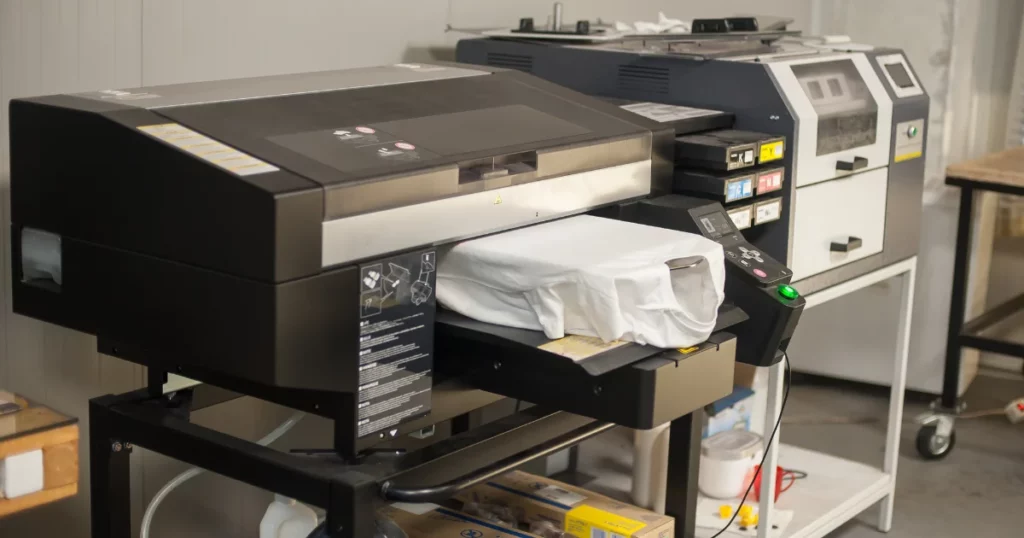
Different types of t shirt printing machines include:
1. The screen printing press is used for pushing ink through the screens onto shirts. It has the features of pallets, a print head, and flash cure units.
2. The heat press machine works by applying heat and pressure onto the fabrics to transfer paper printers through the printable platens.
3. Direct-To-Garment printer is one of the types of t shirt printing that uses Specialized digital printers that print graphics directly onto the t-shirt surface.
4. Sublimation Heat Press Coated heat presses optimized for dye sublimation allowing dyes to infuse fabric polymers.
5. Digital Hybrid Printer Combines digital printheads with screen print pallets for on-demand, multi-color prints.
6. All Over Print Machine Features dip tanks for submerging shirts to absorb photosensitive dyes.
7. Inkjet Printer Standard digital printer using inkjet technology can print to transfer paper.
8. Embroidery Machine Automated stitching of logo or vector designs with a hooping system.
9. Pretreater Machine Applies pretreatment chemicals to shirts to optimize ink adhesion and brightness.
10. Conveyor Dryer Cures inks onto fabrics using heat tunnels to make prints wash durable.
11. Exposure Unit Uses UV light to cure emulsion-coated screens for creating stencils.
12. Washout Booth Enables washing out uncured emulsion to reveal screen print stencil designs.
13. Sonic Welder Uses high-frequency vibrations to embed fabric prints for a soft hand feel.
14. Vacuum Press Press fabrics using strong suction force to adhere prints firmly.
15. The Tubular Knitting Machine Creates seamless blanks for dye sublimation all over prints.
Comparison of Different Types of T Shirt Printing Methods
| Printing Method | Screen Printing | Heat Transfers | DTG Printing | Dye Sublimation |
| Process | Ink pushed through screens to imprint designs | Pre-made transfers applied via heat press | Direct printing on garments with a specialty printer | Dyes infused into polyester fabric |
| Equipment Needed | Screens, ink, squeegee, exposure unit | Color printer, heat press | DTG printer, heat press, pretreat machine | Dye sub printer, heat press |
| Order Volumes Best Suited For | High volume (100+ shirts) | Lower quantities | Lower quantities | Any quantity |
| Number of Colors | Multi-color prints, up to 6 colors | Unlimited colors | Unlimited colors | Unlimited colors |
| Design Types Supported | Simple spot color graphics | Complex full-color photographs | Complex full-color photographs | Complex full-color photographs |
| Location of Prints | Large imprint areas like chest/back | Smaller imprint locations | Smaller imprint locations like chest/sleeves | All-over prints supported |
| Wash Durability | Highly durable | Less durable | Medium wash durability | Extremely durable |
| Print Feel and Texture | Smooth surface feel with mild texture | Light surface feel with transfer film | Very soft feel when washed | Completely smooth embedded feel |
| Cost Per Unit | Lower cost per shirt in high quantities | Affordable at lower quantities | Higher cost per shirt | Medium to high cost per shirt |
| Pros | Cost-effective, bold prints | Great photographic prints | No setup costs | Vibrant embedded prints |
| Cons | Multiple setup steps required | Lower durability | Slow speed for batches | Only works on polyester |
Conclusion
Overall, the numerous types of t shirt printing indicate that various options are indeed available for different design needs and also preferences. Whether it is the traditional appeal of screen printing or the accuracy made possible with DTG, finding affordable custom apparel that suits their needs can increase both the quality and monetary value.
Knowing this, people as well as businesses can make informed decisions when transforming their designs into the t-shirt reality. Hopefully, this guide has revealed the crucial types of t shirt printing techniques practicable and imperative strategic considerations for achieving the best quality prints while retaining profitability for your custom apparel brand.
FAQs – Types of T Shirt Printing
How many types of t shirt printing techniques are there?
Various types of t shirt printing techniques exist that include the screen, heat transfer DTG and also sublimation.
How is the screen printing done on the t shirts?
Screen printing on the t-shirts is a process where layers of ink are applied to the fabric using screens. It is widely used due to its great durability and also bright colors.
What types of t shirt printing are there available in screen printing?
Some of the various types of t shirt printing methods in screen printing are traditional screen, water-based ink and also discharge ink each with their own distinctive advantages and characteristics.
What is the most suitable printing process for the t shirts?
By considering several aspects like design complexity, fabric types oil type, and quantity; the best form of printing for t shirts also varies considerably. For high-volume production, screen printing is preferable whereas, for small runs or intricate designs, the DTG printer comes in handy.
What are the various types of t shirt printing machines available?
Various types of t shirt printing machines include hand-operated screen presses, automatic screens, and the heat transfer units of the press as well as special DTG printers that are developed especially for direct garment decoration.
What modes of t-shirt printing are commonly used in custom types of t shirt printing?
Popular types of t shirt printing methods that are used for custom t shirts include screen printings, digital direct-to-garment ( DTG), and heat transfer which provides great colors.
What are the best types of t shirt printing for my business or any project?
Factors to consider when choosing an appropriate t-shirt printing method include the cost, design complexity, order size, fabric type, and anticipated turnaround time. Consultation with a professional printer can also enable you to make an appropriate decision.
What are the benefits of screen printing as a method for t shirt print?
The benefits of screen printing include high color saturation, lasting durability, and affordably for the mass order custom t shirt.
Could you clarify how the sublimation printing process is a form of t shirt printing?
Sublimation printing is the process of applying dye to the t shirt fabric using heat and pressure so that vibrant, permanent, and photo-realistic prints are produced. It is particularly appropriate for the polyester cloth.
How is t shirt printing classified in terms of the environmental impact?
Water Based and Discharge Ink Screen Printing are environmentally friendly t shirt printing prints because they use minimal chemical components in their production.
Where can I guarantee the quality of the various types of t shirt printing?
To achieve a quality product, the artwork should be provided in high resolution; the right fabric has to be selected for printing and one also needs professional t shirt printers who use premium materials and equipment.
What are the cost factors for various types of t shirt printing?
The costs are determined by the setup cost, quantity printed, the number of colors used in printing, type of fabric, and various services such as assistance with design options and packaging. In some cases, screen printing may be a lot more cost-efficient when ordering in large quantities, while DTG might also be a better option for smaller orders.
Is it possible for me to mix various principles of t shirt printing and use them within one design for a customized tshirt?
Yes, such combinations as various types of t shirt printing can create many peculiar effects and also textures. For instance, the use of both screen printing and heat transfer or embroidery can yield a good-looking design in a 3D custom t shirt.
Do any limits exist in the means by which t shirts can be printed?
Every t shirt printing method has its constraints ranging from color limitations to fabric suitability and also the complexity of custom designs. Knowing these limitations enables one to select the most appropriate printing method for certain design needs.
What are the trends in the types of t shirt printing industry?
The evolving trends in types of t shirt printing include the sustainable and also eco-friendly printing process, working on DTG technology for advancement, and augmented reality with personalized designs involved.
